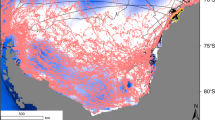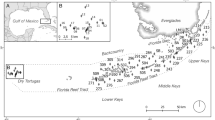Abstract
Sea-ice is a key physical driver of Antarctic marine ecosystems. Understanding ecological effects of sea-ice is particularly important given current and future climate change, but a major obstacle is the impracticality of manipulating sea-ice at a relevant scale. However, large-scale anomalous events, such as those occurring in Commonwealth Bay, East Antarctica, provide opportunities for natural experiments. Historically, katabatic winds have kept Commonwealth Bay ice-free for most of each year, but since 2010, a massive grounded iceberg has resulted in year-round sea-ice cover. We surveyed benthic communities in Commonwealth Bay approximately 3 years after continuous sea-ice cover began and found algal bed communities in severe decline. The majority (~75 %) of large macroalgae were decomposing, and the remainder were discoloured or bleached, while approximately 40 % of encrusting coralline algae were bleached. Accompanying this, the presence of invertebrates such as ophiuroids and polychaetes suggests that communities are in the early stages of transitioning to an invertebrate-dominated state. With a known start date, monitoring benthic communities in Commonwealth Bay will allow quantification of rates of benthic regime shifts in response to sea-ice cover, and improve understanding of the vulnerability of polar ecosystems to climate change.




Similar content being viewed by others
References
Aguilera J, Karsten U, Lippert H, Vogele B, Philipp E, Hanelt D, Wiencke C (1999) Effects of solar radiation on growth, photosynthesis and respiration of marine macroalgae. Mar Ecol Prog Ser 191:109–119
Mayewski PA et al (2009) State of the Antarctic and Southern Ocean climate system. Rev Geophys 47:RG1003
Amsler CD, McClintock JB (1998) Chemical defence against herbivory in the Antarctic marine macroalgae Iridaea cordata and Phyllophora antarctica (Rhodophyceae). J Phycol 34:35–59
Anderson MJ (2001) A new method for non-parametric multivariate analysis of variance. Austral Ecol 26:32–46. doi:10.1111/j.1442-9993.2001.01070.pp.x
Anderson MJ, Gorley RN, Clarke KR (2007) Permanova + for primer: guide to software and statistical methods. Primer-E, Plymouth
Baird HP, Miller KJ, Stark JS (2011) Evidence of hidden biodiversity, ongoing speciation and diverse patterns of genetic structure in giant Antarctic amphipods. Mol Ecol 20:3439–3454
Barnes DKA (1996) Low levels of colonisation in Antarctica: the role of bryozoans in early community development. In: Gordon DP, Smith AM, Grant-Mackie JA (eds) Bryozoans in space and time. National Institute of Water and Atmospheric Research, Wellington, p 442
Barnes DKA, Souster T (2011) Reduced survival of Anarctic benthos linked to climate-induced iceberg scouring. Nat Clim Change 1:365–368
Bintanja R, van Oldenborgh GJ, Drijfhout SS, Wouters B, Katsman CA (2013) Important role for ocean warming and increased ice-shelf melt in Antarctic sea-ice expansion. Nat Geosci 6:376–379
Boé J, Hall A, Qu X (2009) September sea-ice cover in the Arctic Ocean projected to vanish by 2100. Nat Geosci 2:341
Brey T, Dahm C, Gorny M, Klages M, Stiller M, Arntz WE (1996) Do Antarctic benthic invertebrates show an extended level of eurybathy? Antarct Sci 8(1):3–6
Brown KM, Fraser KPP, Barnes DKA, Peck LS (2004) Links between the structure of an Antarctic shallow-water community and ice-scour frequency. Oecologia 141:121–129
Campana GL, Zacher K, Fricke A, Molis M, Wulff A, Quartino ML, Wiencke C (2009) Drivers of colonization and succession in polar benthic macro- and microalgal communities. Bot Mar 52:655–667
Campbell AH, Harder T, Nielsen S, Kjelleberg S, Steinberg PD (2011) Climate change and disease: bleaching of a chemically defended seaweed. Glob Change Biol 17:2958–2970
Campbell AH, Verges A, Steinberg PD (2014) Demographic consequences of disease in a habitat-forming seaweed and impacts on interactions between natural enemies. Ecology 95:142–152
Clark GF, Stark JS, Johnston EL, Runcie JW, Goldsworthy PM, Raymond B, Riddle MJ (2013) Light-driven tipping points in polar ecosystems. Glob Change Biol 19:3749–3761
Clark GF, Raymond B, Riddle MJ, Stark JS, Johnston EL (2015) Vulnerability of Antarctic shallow invertebrate-dominated ecosystem. Austral Ecol. doi:10.1111/aec.12237
Connell SD (2007) Water quality and the loss of coral reefs and kelp forests: alternative states and the influence of fishing. In: Connell SD, Gillanders BM (eds) Marine ecology. Oxford University Press, Melbourne
Dunbar RB, Anderson JB, Stockton WL (1989) Biogenic sedimentation in McMurdo Sound, Antarctica. Mar Geol 85:155–179
Filinger L, Janussen D, Lundalv T, Richter C (2013) Rapid glass sponge expansion after climate-induced Antarctic ice shelf collapse. Curr Biol 23:1330–1334
Fuiman L, Davis R, Williams T (2002) Behavior of midwater fishes under the Antarctic ice: observations by a predator. Mar Biol 140:815–822. doi:10.1007/s00227-001-0752-y
Gorman D, Connell SD (2009) Recovering subtidal forests in human-dominated landscapes. J Appl Ecol 46:1258–1265
Gutt J (2001) On the direct impact of ice on marine benthic communities, a review. Polar Biol 24:553–564
Gutt J, Starmans A, Dieckmann G (1996) Impact of iceberg scouring on polar benthic habitats. Mar Ecol Prog Ser 137:311–316
Gutt J, Barnes DKA, Lockhart SJ, van de Putte A (2013a) Antarctic macrobenthic communities: a compilation of circumpolar information. Nat Conserv 4:1–13
Gutt J, Griffiths HJ, Jones CD (2013b) Circumpolar overview and spatial heterogeneity of Antarctic macrobenthic communities. Mar Biodivers 43:481–487
Harrold C, Reed DC (1985) Food availability, sea urchin grazing, and kelp forest community structure. Ecology 66:1160–1169
Irving AD, Connell SD, Elsdon TS (2004) Effects of kelp canopies on bleaching and photosynthetic activity of encrusting coralline algae. J Exp Mar Biol Ecol 310:1–12
Irving AD, Connell SD, Johnston EL, Pile AJ, Gillanders BM (2005) The response of encrusting coralline algae to canopy loss: an independent test of predictions on an Antarctic coast. Mar Biol 147:1075–1083
Johnston EL, Connell SD, Irving AD, Pile AJ, Gillanders BM (2007) Antarctic patterns of shallow subtidal habitat and inhabitants in Wilke’s Land. Polar Biol 30:781–788
Kidson E (1946) Meteorology. Discussions of Observations at Adélie Land, Queen Mary Land and Macquarie Island. Sydney
Kortsch S, Primicerio R, Beuchel F, Renaud PE, Rodrigues J, Jørgen Lønne O, Gulliksen B (2012) Climate-driven regime shifts in Arctic marine benthos. Proc Natl Acad Sci. doi:10.1073/pnas.1207509109
Krause-Jensen D et al (2012) Seasonal sea ice cover as principal driver of spatial and temporal variation in depth extension and annual production of kelp in Greenland. Glob Change Biol. doi:10.1111/j.1365-2486.2012.02765.x
Kühl M, Glud RN, Borum J, Roberts R, Rysgaard S (2001) Photosynthetic performance of surface-associated algae below sea ice as measured with a pulse-amplitude-modulated (PAM) fluorometer and O2 microsensors. Mar Ecol Prog Ser 223:1–14
Lohrer AM, Cummings VJ, Thrush S (2013) Altered sea ice thickness and permanance affects benthic ecosystem functioning in coastal Antarctica. Ecosystems 16:224–236
Lucas AHS (1919) The Algae of Commonwealth Bay. Sydney, Australia
Marzinelli EM, Underwood AJ, Coleman RA (2011) Modified habitats influence kelp epibiota via direct and indirect effects. PLoS ONE 6:e21936
Mawson D (1940) Marine biological programmme and other zoological and botanical activities, vol 2. University of Adelaide, Sydney, Australia
Miles BWJ, Stokes CR, Vieli A, Cox NJ (2013) Rapid, climate-driven changes in outlet glaciers on the Pacific coast of East Antarctica. Nature 500:563–567. doi:10.1038/nature12382
Parish TR, Walker R (2006) A re-examination of the winds of Adélie Land, Antarctica. Aust Meteorol Mag 55:105–117
Parkinson CL (2004) Southern Ocean sea ice and its wider linkages: insights revealed from models and observations. Antarct Sci 16:387–400
Pritchard HD, Vaughan DG (2007) Widespread acceleration of tidewater glaciers on the Antarctic Peninsula. J Geophys Res 112: F03S29. doi:10.1029/2006JF000597
Quartino ML, Deregibus D, Campana GL, Latorre GEJ, Momo FR (2013) Evidence of macroalgal colonization on newly ice-free areas following glacial retreat in potter cove (South Shetland Islands), Antarctica. PLoS ONE 8:e58223. doi:10.1371/journal.pone.0058223
Rignot E, Casassa G, Gogineni P, Krabill W, Rivera A, Thomas R (2004) Accelerated ice discharge from the Antarctic Peninsula following the collapse of Larsen B ice shelf. Geophys Res Lett. doi:10.1029/2004GL020697
Runcie JW, Riddle MJ (2006) Photosynthesis of marine macroalgae in ice-covered and ice-free environments in East Antarctica. Eur J Phycol 41:223–233
Scheffer M, Carpenter S (2003) Catastrophic regime shifts in ecosystems: linking theory to observation. Trends Ecol Evol 18:648–656
Shadwick EH et al (2013) Glacier tongue calving reduced water formation and enhanced carbon uptake. Geophys Res Lett 40:904–909
Smale DA, Brown KM, Barnes DKA, Fraser KPP, Clarke A (2008) Ice scour disturbance in Antarctic waters. Science 321:371
Stanwell-Smith D, Barnes DKA (1997) Benthic community development in Antarctica: recruitment and growth on settlement panels at Signy Island. J Exp Mar Biol Ecol 212:61–79
Tamura T, Williams GD, Fraser AD, Ohshima KI (2012) Potential regime shift in decreased sea ice production after the Mertz Glacier calving. Nature Comms 3:826. doi:10.1038/ncomms1820
Wahl M, Hay ME (1995) Associational resistance and shared doom—effects of epibiosis on herbivory. Oecologia 102:329–340
Zacher K, Rautenberger R, Hanelt D, Wulff A, Wiencke C (2009) The abiotic environment of polar marine benthic algae. Bot Mar 52:483–490
Acknowledgments
We thank members of the Australasian Antarctic Expedition 2013–2014 (www.spiritofmawson.com) for their support of this study. GFC was supported by a UNSW Strategic Research Grant awarded to ELJ. EMM thanks SIMS and Director PD Steinberg for additional support. Work was conducted under Antarctic Treaty (Environment Protection) permit number ATEP 13-14-AAE 2013.
Author information
Authors and Affiliations
Corresponding author
Rights and permissions
About this article
Cite this article
Clark, G.F., Marzinelli, E.M., Fogwill, C. et al. Effects of sea-ice cover on marine benthic communities: a natural experiment in Commonwealth Bay, East Antarctica. Polar Biol 38, 1213–1222 (2015). https://doi.org/10.1007/s00300-015-1688-x
Received:
Revised:
Accepted:
Published:
Issue Date:
DOI: https://doi.org/10.1007/s00300-015-1688-x




